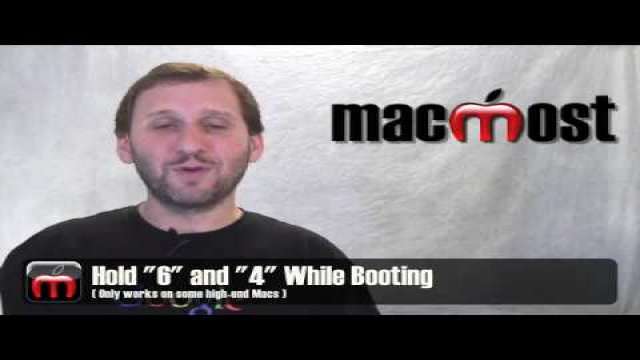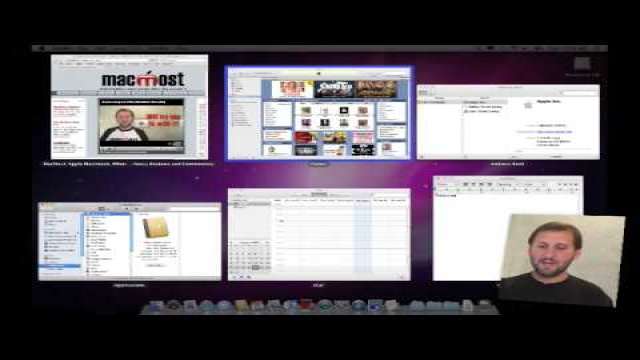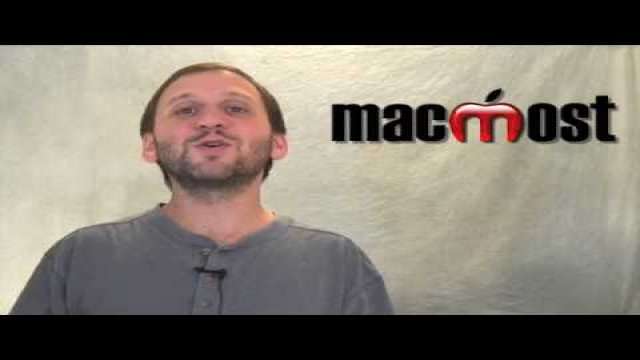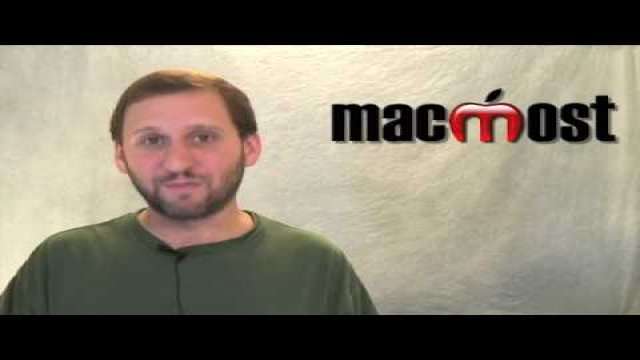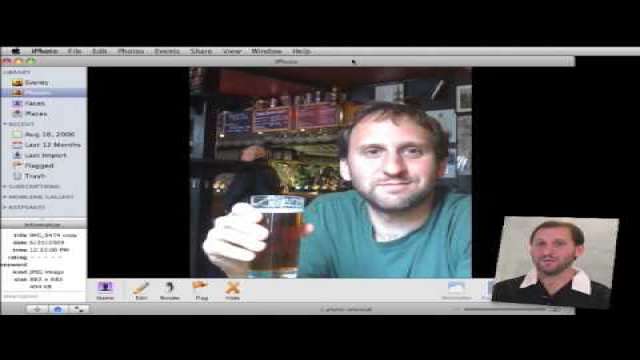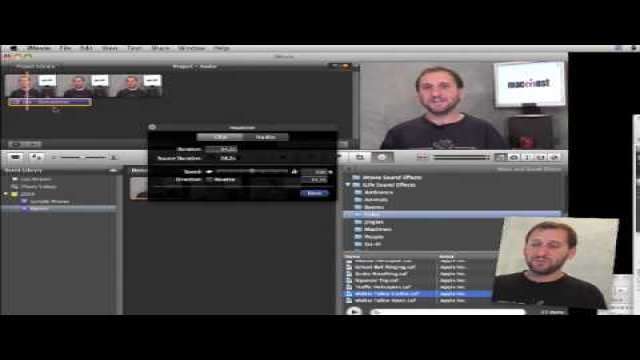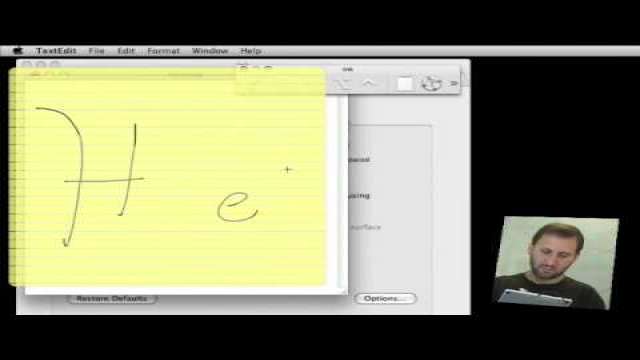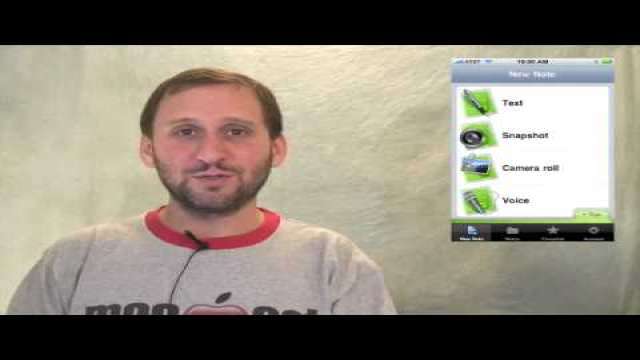I could swear that the front page of Apple looked like this for a minute tonight. Maybe I was imagining it…
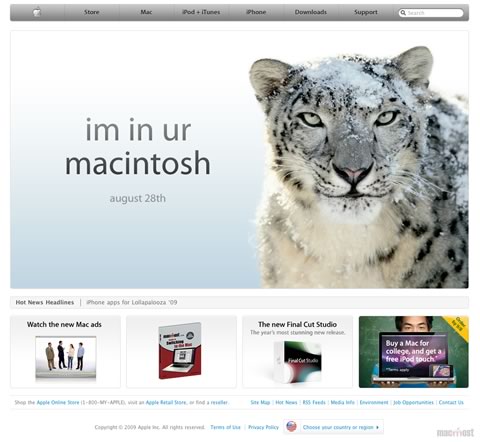
Or, maybe it was this:
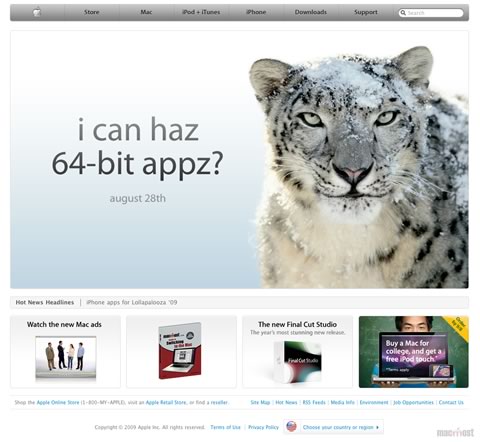
Or, perhaps:

 Apple shocked the Mac news world on Monday with the announcement that Snow Leopard would be released in only 5 days. Tomorrow, Friday August 28, it will be available in Apple stores and ship on new Macs.
Apple shocked the Mac news world on Monday with the announcement that Snow Leopard would be released in only 5 days. Tomorrow, Friday August 28, it will be available in Apple stores and ship on new Macs.
The price of a single upgrade from Leopard is $29. Anyone who bought a Mac on or after June 8 can get it for $10 if they sign up at the Apple site and order within 90 days of their Mac purchase.
You can find out more about Snow Leopard and how to upgrade in this week’s videos: Snow Leopard FAQ and The Top 10 Reasons to Upgrade to Snow Leopard.
Analysts at Piper Jaffray have forecasted that the new version of Mac OS X will sell 5 million copies in this next quarter. Meanwhile, other reports are coming in that computer sales in general are up, with Apple leading the pack in growth once again. Apple has started running some new TV spots as well.
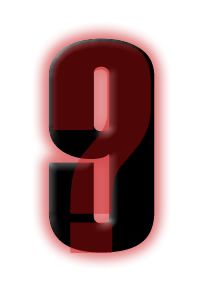 Apple news this week has been dominated by rumors of a September 9, 2009 (9/9/9) event. While there has been no official announcement of such an event by Apple, this hasn’t stopped bloggers from speculating on what APple may announce. Here is a run-down of possibilities.
Apple news this week has been dominated by rumors of a September 9, 2009 (9/9/9) event. While there has been no official announcement of such an event by Apple, this hasn’t stopped bloggers from speculating on what APple may announce. Here is a run-down of possibilities.
It could be the Apple Tablet that we have been waiting for. Most rumors of this mythical tablet have pointed to later in the year, or early next year for release. But Apple announced the iPhone 6 months in advance, so they could be announcing this tablet early too. If the tablet relies on iPhone apps for content, then an early announcement would give app developers time to adapt their apps to a larger tablet screen.
Apple seems to have September announcements concerning the iPod in most recent years. So this could be an iPod update. There have been rumors of a new iPod Touch that adds a camera and other iPhone features. Add a larger screen and maybe the new iPod Touch and a tablet are one in the same.
One of the rumors that makes the most sense is the release of iTunes 9. Rumored features for this new version are social media links and the ability to sync with non-iPod devices. Apple may want that last feature to keep iTunes as the center of the Mac users’ media world, instead of resorting to a third-party application to sync with their non-iPod device.
The very date of 9/9/9 hints at the Beatles. The words “Number 9, Number 9, Number 9” are from the oddest Beatles song, Revolution Number 9 from the White Album, and are heavily associated with the Beatles in popular culture. The Beatles appearing on iTunes has been rumored for years. 9/9/9 is the release date of the Beatles Rock Band game for game consoles, and the issue of a remastering of the Beatles catalog. This remastering is often linked with the Beatles coming to iTunes. This could also include a limited edition Beatles iPod, similar to the U2 iPod from years ago.
Another possibility could be that September 9 is simply the release of Snow Leopard. This would be a non-event, as Apple has already said that Snow Leopard will be out in September. The only surprise would be if Snow Leopard boxes were unveiled at Apple Stores and it was available immediately.
Of course, the event could be any combination of the above. Throw in a surprise like Steve Jobs making the announcement personally, perhaps with Paul McCartney and Ringo Starr at his side, and it could be quite exciting.
Even though Apple doesn't sell T-shirts, there are still plenty of places on the Web where you can buy a shirt to proclaim that you are a fan of Apple, the Mac, iPod or iPhone.
 Looks like Snow Leopard really is on target for a September release, if not sooner. Rumor has it that the beat went gold — meaning that it has been sent to factories to be duplicated on to install disks. If that is true, we could see Snow Leopard on sale by the end of the month.
Looks like Snow Leopard really is on target for a September release, if not sooner. Rumor has it that the beat went gold — meaning that it has been sent to factories to be duplicated on to install disks. If that is true, we could see Snow Leopard on sale by the end of the month.
It would be interesting, as Apple could then brag that they beat their own release deadline, as opposed to Microsoft having OS release deadlines slip by months and even years.
How iPhone treats iPhone app developers has continued to be a hot topic this week, with more developers telling their stories and more bloggers writing about it. Apple’s VP Phil Schiller responded to one complaining developer by email and said that Apple is listening to the complaints. An interesting list of rejected iPhone apps can be found here. Aside from a few that were rejected for obvious objectionable content, there is plenty of evidence of Apple’s app reviewers disagreeing with each other and making contradictory calls.
Apple made some small product adjustments this week. They released a bug fix update to Safari, version 4.0.3, available through Software Update. They also resumed offering matte screen options for 15-inch MacBook Pros, much to the delight of those who favored matte screens over the standard glossy versions.
 Apple released a new version of Leopard, Mac OS 10.5.8 this week. To get the new version, simply choose Software Update from the Apple menu. It includes mostly minor security and stability fixes, as outlined in Apple’s official update note.
Apple released a new version of Leopard, Mac OS 10.5.8 this week. To get the new version, simply choose Software Update from the Apple menu. It includes mostly minor security and stability fixes, as outlined in Apple’s official update note.
Apple also released version 5.1 of GarageBand, part of iLife 09. You can get that one from Software Update as well. Changes include adding GarageBand track effects and Audio Units to a guitar track, improved support for Apogee audio interfaces, Magic GarageBand switches to full screen faster and some security fixes.
Eric Schmidt, the CEO of Google, has resigned from the Apple, Inc. board of directors. This is a reaction to Google entering the OS business with the announcement of Google Chrome. With Apple and Google competing in a number of areas now, it was only a matter of time before Schmidt would have had to leave.
The best thing about the iPhone is that you can add third-party apps to it. Find out which apps you should add to your iPhone right away. Here are 11 free iPhone apps to get you started. You can search for product and resaurant reviews, check movie times, update your Facebook page, read books, draw pictures and even talk to your iPhone.
 In the past week Apple has introduced a whole new version of the Final Cut Studio suite, including Final Cut Pro 7. New features include an easy export option, posting to MobileMe and YouTube and support for new ProRes codecs. Final Cut Pro is now Intel-only, matching Snow Leopard, and has a number of bug fixes and optimizations. The price for Final Cut Studio has dropped to only $999 and upgrades for $299.
In the past week Apple has introduced a whole new version of the Final Cut Studio suite, including Final Cut Pro 7. New features include an easy export option, posting to MobileMe and YouTube and support for new ProRes codecs. Final Cut Pro is now Intel-only, matching Snow Leopard, and has a number of bug fixes and optimizations. The price for Final Cut Studio has dropped to only $999 and upgrades for $299.
Apple has also released a new version of the Time Capsule base station. You can get the original 1TB Time Capsule for $299 and then new 2TB for $499. 2TB will make Time Capsule useable as a Time Machine backup for those who have a 1TB drive in their Mac, as well as those who have several Macs on their network with total drive space of more then 1TB.
Rumors this week, besides more talk about a Mac tablet or netbook, centered around whether Apple would attend the Consumer Electronics Show in Las Vegas next year. In the past, Apple hasn’t attended because it usually conflicts with MacWorld. But as Apple is no longer involved with MacWorld, there are rumors that Apple may attend and that Steve Jobs may even replace Bill Gates as the headline speaker. But no definite word from Apple either way.
It seems that there is always a new controversy surrounding iPhone App Store submissions. This last week several Google Voice-related apps have been removed from the store by Apple. Google Voice is a telephone service run by Google that combines voice mail, a personal phone number and call forwarding, among other features. Apps have allowed iPhone owners to access various features of Google Voice. Developers are upset at their sudden rejection and can only speculate as to Apple’s reasons.

